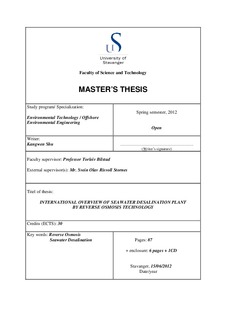| dc.description.abstract | In a world faced with increased urbanization, population growth, climate change and degradation of water supplies, the importance of a reliable source of technology to provide fresh water emphasizes the importance of seawater desalination.
Over the years a variety of seawater desalination methods have been developed throughout the world. The most common technologies available for desalination around the world are membrane reverse osmosis (RO), thermal distillation (TD) and electrodialysis (ED).
In this thesis, thermal distillation and membrane technologies are described. Thermal distillation is a process that boiling of saline water with condensation and recovery of the vapors. For many years distillation was the predominant process for the treatment of seawater. In the last two decades, due to the membrane technology improvements, seawater desalination by reverse osmosis is now considered a viable alternative technology for production of potable water on a large scale, membrane plants have captured an increasing share of the seawater desalination market. As compared to other technologies, it has low energy consumption, low costs and easier to operate.
5 SWRO plants around the world with different production capacity, membrane types and process designs are described. These plants have similar process designs, including pretreatment, reverse osmosis and post-treatment processes. However, they are very different in the details of the design, including conventional or UF/MF method for pretreatment, double or triple pass system for reverse osmosis, the selection of reverse osmosis membrane and discharge of concentrated water. There are many different kinds of combinations for a SWRO plant. This is determined by many factors. But no matter which one we choose, the aim is to spend less energy consumption to produce fresh water as much as possible from seawater.
Reverse osmosis membranes will be dominant technology for seawater desalination in the future. The paper will give the valued customers an insight about how does the SWRO plant work and how far the trend of the reverse osmosis technologies has gone in the seawater desalination market. | no_NO |
